Reproduction in Angiosperms.

Reproduction in angiosperms.
What is a flower?
- A flower is the sexual reproductive part of a flowering plant or angiosperm.
- It contains the sex organs (ovary and anther) of the plant.
- A fertilized flower (ovule) develops into fruits that may contain a seed or seeds.

Describe the four floral parts of a flower.
- Corolla:
- It is a collection or a group of petals.
- It is found inside the calyx.
- It is usually brightly coloured in insect-pollinated flowers but it is dull in wind-pollinated flowers.
- They may also contain nectar.
- The petals maybe three, four or more in number.
- Calyx:
- It is a collection or a group of sepals.
- Sepals are usually leaf-like and green in appearance.
- They are the outermost whorl and are located at the bottom of the flower.
- Sepals may be fused or free.
- Flowers with fused sepals are known as polysepalous flowers.
- But flowers with free sepals are known as gamosepalous flowers.
- Androecium:
- It is a collection of stamen.
- It is also the male reproductive part of the flower.
- It consists of the filament and an anther.
- The filament is a stalk that supports the anther which is usually a four-lobed structure which contains pollen grain.
- Gynoecium:
- It is a collection of a group of pistils or carpels on a flower.
- It is also the female reproductive part of a flower.
- Carpel consist of the stigma, style and ovary.
- The style serves as a link between the stigma and the ovary.
- Stigma receives pollen grains during pollination.
- The ovary contains the female gamete (ovule).
List adaptive features of anemophilous flower or wind-pollinated flower
- Anemophilous flowers are small in size and inconspicuous.
- They are dull in colour.
- Anemophilous flowers produce a large number of pollen grains.
- They also have elongated filaments and are flexible.
- The pollen grains are lighter in size.
- They usually lack nectar.
- The flowers have a feathery stigma for trapping floating pollen grains.
State the adaptive features of entomophilous flowers or insect-pollinated flowers.
- Entomophilous flowers are sweet-scented.
- They are brightly coloured and have conspicuous petals.
- They also have sticky and large pollen grains.
- Entomophilous flowers possess nectar.
- Flowers have hairy and sticky stigmas.
- Filaments and styles are usually stout and strongly built.
- Moreover, entomophilous flowers produce a limited amount of pollen grains.
Explain dormancy and state its importance to organisms.
- Dormancy is the period in the life cycle of an organism in which the growth and development of the organism are suspended.
- The rate of metabolic activities reduces to a level just enough to keep the organism alive.
- The organism depends on food reserves for survival and metabolic activities.
- Dormancy is also an adaptation to survive unfavourable environmental conditions.
- Dormancy is important to organisms both plants and animals in the following ways;
- It allows a period for the dispersal of seeds and fruits.
- Helps the organism to withstand unfavourable environmental conditions.
- It also allows organisms to further develop some internal organs and prepare for the next life cycle.
Explain aestivation and hibernation.
- Aestivation is a phenomenon whereby some organism (animals) goes into a state of inactivity during dry conditions or drought to prevent them from dehydration leading to death.
- Hibernation is also the phenomenon that occurs in some animals when the temperature becomes very low at the temperate zones to prevent death.
What is a fruit?
- A fruit is a fertilized ovary which may contain seed/seeds which are enclosed in a pericarp.
What are parthenocarpic plants?
- Parthenocarpic plants are plants that develop from unfertilized ovules and are therefore seedless plants.
Explain why unripe fruits are sour and ripe fruits have a sweet taste.
- Unripe fruits taste sour because of the presence of organic acids such as acetic acid.
- Ripe fruits taste sweet because the organic acids present in the fruit are converted to sugars.
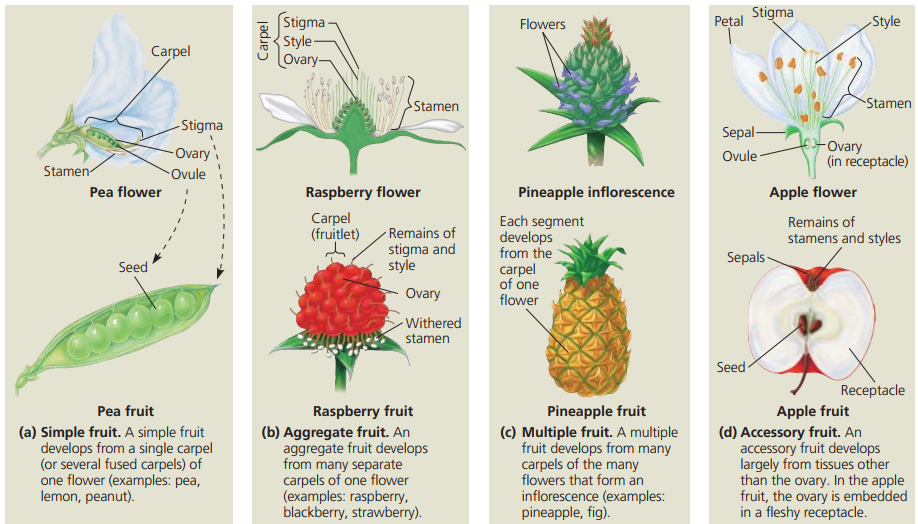
What is placentation in angiosperm?
Placentation is the mode of arrangement of the ovule (placentae) in the ovary (fruit).
State the types of placentation and give examples of flowers or fruits in which they can be found.
1. Parietal placentation;
- It is found in ovaries with one chamber (unilocular ovaries).
- The ovules are attached to the inner walls on projections that form incomplete chambers.
Examples include;
- mustard fruits/flowers,
- pawpaw fruit/flowers and
- cucumber fruits/flowers.
2. Axile placentation;
- It is found in ovaries with more than two chambers (locules).
- The ovule is arranged to the central axis of the ovary where the carpels are fused but are separated by septa.
Examples include;
- Hibiscus flower
- Orange fruits/flower
- Okra fruit/flower
- Tomatoes fruits/flower
3. Free central placentation;
- It occurs in ovaries with one locule (unilocular ovary).
- The ovules are arranged freely around the central axis but they are not separated by septa.
Examples include;
- Waterleaf (Talinum triangulare)
- Pepper
4. Marginal placentation;
- It also occurs in unilocular ovaries.
- The ovules are arranged on an elongated placenta formed at the ventral suture of the ovary in a row or two along the margin.
Examples include;
- Cassia fruit/flower
- Ground
- Crotalaria fruit/flower
- Garden pea
5. Basal placentation;
- The ovaries are unilocular
- The ovules are usually arranged at the base of the ovaries.
Examples include;
- Tridax fruit/flower
- Sunflower
What is a floral formula?
- Floral formula can be defined as a shorthand formula with specific letters, symbols and numbers that are used to describe the structure of a flower.
- The formula usually provides information about the sexuality, the number of each calyx, corolla, androecium, gynoecium and the floral symmetry of the flower.
Describe the adaptive features of cross-pollinated flowers.
- Cross-pollination occurs in dioecious plants.
Dioecious plants are species of plant with both male and female flowers growing on separate plants.
Self-pollination is impossible and cross-pollination is the only means through which the plant can be pollinated.
It occurs in pawpaw.
- Cross-pollinated flowers/ plants are Dichogamous.
Dichogamous plants are species of plants in which the stamens and the carpels on the same flower mature at different times.
There are two forms of dichogamy which are;
Protandry is when the stamen matures before the carpels on the same flower.
Example crotalaria and sunflower.
Protogyny is when the carpels mature before the stamens on the same flower.
Examples are water lettuce and Dutchman’s apple plants.
- It also occurs in self-incompatible flowers.
The pollen of the flower cannot fertilise its ovules.
- Cross-pollination flowers usually have a long filament and short style or may have a short filament and long style.
State the adaptive features of fruits and seeds dispersed by wind.
- They are small in size.
- Light in weight and usually dry.
- Development of floss (entangled mass of hair or silky thread). Examples are silk cotton, Dandelion fruit and Willow seeds.
- Calyx modified to form a parachute structure (pappus). Examples are Tridax and Chromolina.
- Expansion of testa to form a wing-like structure that keeps them floating. Examples are Combretum, Tecoma, Cincoma, and Tridax.
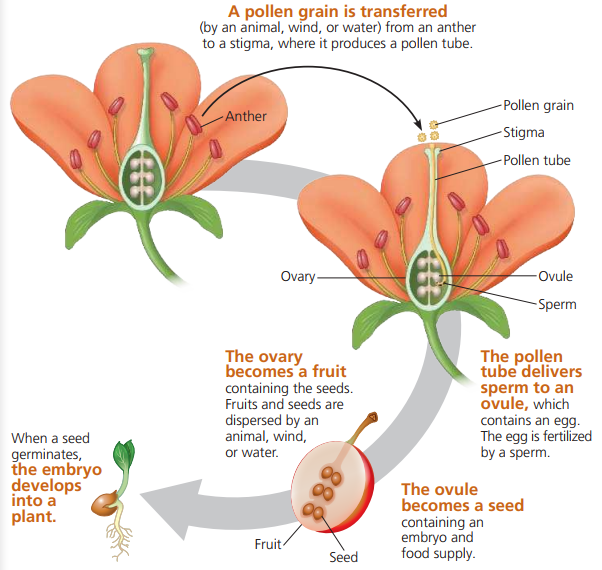
TRY THE FOLLOWING
Explain the following terms;
- Monocarpous flower
- Syncarpous flower
- Apocarpous flower
- Hypogynous flower
- Epigynous flower
- Cauline flower
- Perianth
- Bract
State the adaptive features of self-pollinated flowers.
Describe how insects aid in the pollination of flowers.
SUMMARY OF SOME VITAL PROCESSES IN ANGIOSPERMS
1. The process leading to the formation of the female gametophytes
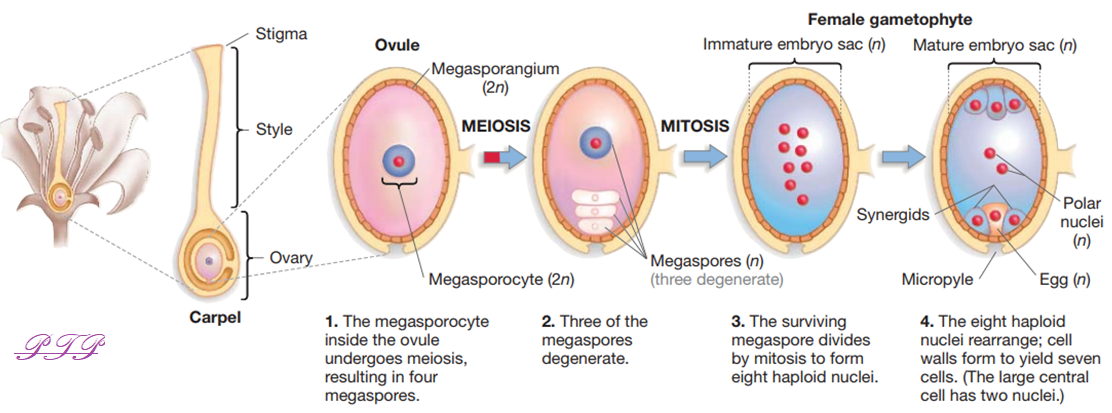
2. The process leading to the formation of the male gametophyte
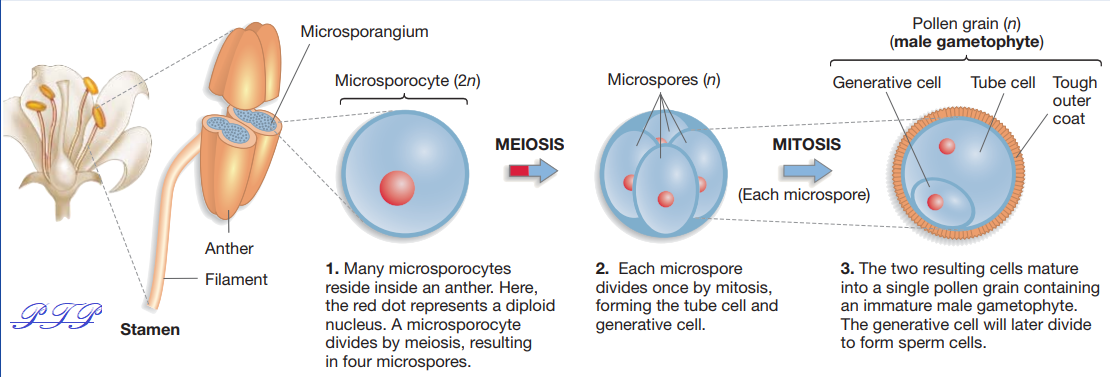
3. The growth of pollen tubes and fertilization in angiosperms
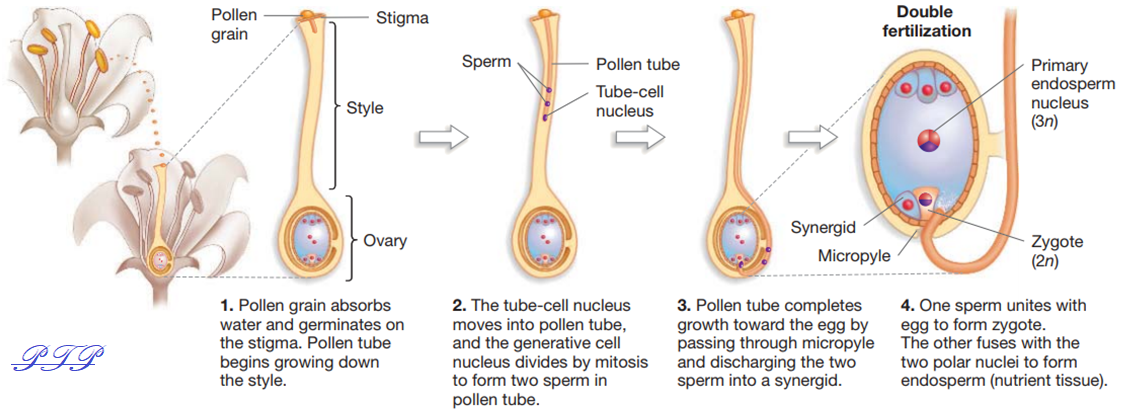
4. Embryo development and seed maturation

Join Enlighten Knowledge WhatsApp Channel.
Join Enlighten Knowledge Telegram platform.





